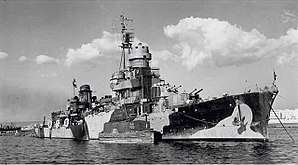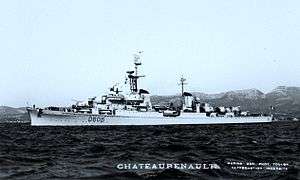French cruiser Guichen (D 607)
Guichen (D 607) was a French Capitani Romani-class light cruiser, acquired as war reparations from Italy in 1947 which served in the French Navy from 1948 to 1961. It was named in honour of Luc Urbain de Bouëxic, comte de Guichen. In Italian service, it was named Scipione Africano after Publius Cornelius Scipio Africanus, the Roman general and later consul.
 Scipione Africano surrendering at Malta on 9 September 1943 | |
| History | |
|---|---|
| Name: | Guichen |
| Namesake: | Luc Urbain de Bouëxic, comte de Guichen |
| Ordered: | 1937[1] |
| Laid down: | 28 September 1939 |
| Launched: | 12 January 1941 |
| Commissioned: | 1942 - Italy 1948 - France |
| Decommissioned: | 1961 |
| In service: | 23 April 1943 |
| Struck: | 1961 |
| Fate: | Scrapped, 1979 |
| General characteristics | |
| Type: | Light cruiser |
| Displacement: |
|
| Length: | 142.2 m (466 ft 6 in) overall |
| Beam: | 14.4 m (47 ft 3 in) |
| Draught: | 4.1 m (13 ft 5 in) |
| Propulsion: | |
| Speed: | 41 knots (76 km/h; 47 mph)[2] |
| Range: | 4,350 nmi (8,060 km; 5,010 mi) at 18 knots (33 km/h; 21 mph) |
| Complement: | 418 |
| Sensors and processing systems: | Gufo radar |
| Armament: |
|
History
Regia Marina Service
Scipione Africano was commissioned in September 1942 in Livorno. She was the only member of her class to see saw combat. Equipped with the Italian-developed EC.3 Gufo radar,[3] she detected and engaged four British Elco motor torpedo boats lurking five miles (8.0 km) ahead during the night of 17 July 1943, while passing the Messina straits at high speed off Punta Posso.[4] She sank MTB 316 and heavily damaged MTB 313 between Reggio di Calabria and Pellaro.[5][6][7] The engagement lasted no more than three minutes.[4] Scipione Africano suffered minor damage and two injuries among its crew when German and Italian artillery batteries deployed along the Italian coast opened fire in the aftermath. The cruiser had been ordered from La Spezia to Taranto, which she eventually reached at 9:46 AM. Her high speed was decisive to the outcome of the battle.
After her eventful passage into the Ionian Sea, she laid down four minefields in the Gulf of Taranto and the Gulf of Squillace from 4 to 17 August, together with the old light cruiser Luigi Cadorna.[8] At the armistice on 9 September 1943, she sailed to Malta on the next day to surrender together with the fleet.
Marine Nationale Service
After the Peace Treaty on 10 February 1947, she and her sister ship Attilio Regolo were transferred to France as war reparations (Attilio Regolo was renamed Chateaurenault). The ships were extensively rebuilt for the French Navy by La Seyne dockyard with new anti-aircraft-focused armament and fire-control systems in 1951–1954 with the following characteristics:
- Displacement
- Length
- Beam
- Draught
- Machinery - unchanged
- Armament
- 6 – 105 mm guns (three twin turrets of German origin)
- 10 – 57 mm guns (5 twin turrets
- 12 – 550 mm torpedo tubes
- Sensors: Radar DRBV 20 A, DRBV 11, DRBC 11, DRBC 30, Sonar
- Crew: 353

The ships were decommissioned in 1961.[9]
Citations
- Preston, Antony (1989). Jane's Fighting Ships of World War II. New York, New York: Military Press. ISBN 0-51767-963-9
- "Pompeo Magno—Incrociatore leggero". Almanacco storico navale. Marina Militare.
- Ando, Part 1, p. 155
- De Pellegrini Dai Coi, Maurizio (January 2012). "Scipione: posto di combattimento". Rivista Marittima (in Italian). Marina Militare: 28–40.
- Pope, Dudley (1998). Flag 4: The Battle of Coastal Forces in the Mediterranean 1939–1945. Chatham Publishing. pp. 121–122. ISBN 1-86176-067-1.
- Fioravanzo, Giuseppe (1970). Le azioni navali in Mediterraneo dal 1° aprile 1941 all'8 settembre 1943 (in Italian). Ufficio Storico della Marina Militare. pp. 468–469.
- Baroni, Piero (2007). La guerra dei radar: il suicidio dell'Italia 1935/1943 (in Italian). Greco & Greco. p. 187. ISBN 8879804316.
- Cocchia, Aldo (1966). La Marina italiana nella seconda guerra mondiale, volume 18. Ufficio Storico della Marina Militare. p. 397.
- Bishop (2002), p. 489.
References
- Bishop, Chris (2002). The Encyclopedia of Weapons of WWII: The Comprehensive Guide to Over 1,500 Weapons Systems, Including Tanks, Small Arms, Warplanes, Artillery, Ships, and Submarines. Sterling Publishing. ISBN 1-58663-762-2.
- Brescia, Maurizio (2012). Mussolini's Navy: A Reference Guide to the Regina Marina 1930–45. Annapolis, Maryland: Naval Institute Press. ISBN 978-1-59114-544-8.
- Chesneau, Roger, ed. (1980). Conway's All The World's Fighting Ships 1922–1946. London: Conway Maritime Press. ISBN 0-85177-146-7.
- Fraccaroli, Aldo (1968). Italian Warships of World War II. Shepperton, UK: Ian Allan. ISBN 0-7110-0002-6.
- Whitley, M. J. (1995). Cruisers of World War Two: An International Encyclopedia. Annapolis, Maryland: Naval Institute Press. ISBN 1-55750-141-6.
- Preston, Antony (1989). Jane's Fighting Ships of World War II. New York, New York: Military Press. ISBN 0-51767-963-9.